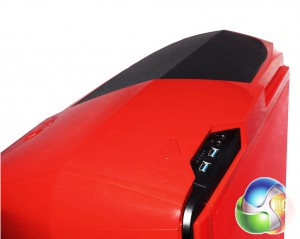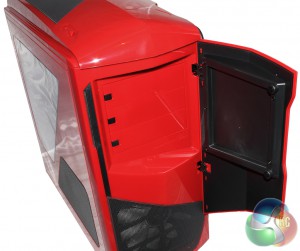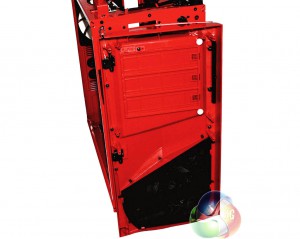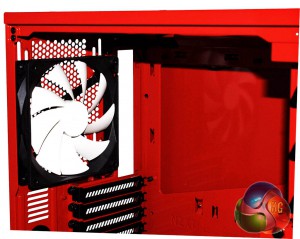
Today we are taking a look at the NZXT Phantom 530. As the direct successor to the original Phantom, the Phantom 530 aims to impress with support for radiators up to 360 mm in size, graphics cards up to 444 mm in length, CPU coolers up to 183 mm in height and a whopping 34 mm of cable management clearance. Retailing for £104,99 inc vat., is the Phantom 530 a worthy successor?
The NZXT Phantom 530 is available in three colors: Black, White and Red. We are reviewing the Red model today.
Specifications:
- Size: Full Tower
- Drive Bays: 3 x 5.25″ (External), 6 x 3.5″/2.5″ (Internal), 6 + 1 2.5″ (Internal)
- CPU Cooler Support: 183 mm
- Graphics Card Support: 282 mm (with cage & pivot fan), 310 mm (with cage), 444 mm (without cage)
- Cable Management Clearance: 26 mm (lowest point) / 34 mm (highest point)
- Dimensions: 235 mm x 572 mm x 543 m
- Material: Steel, Plastic
- Motherboard Support: ITX, Micro-ATX, ATX, EATX (322 x 272 mm)
- Expansion Slots: 8
- External Electronics: 1 x Audio/Mic, 2 x USB 3.0
- Weight: 10.5 kg / 23.15 lbs
- Warranty: 2 years
The NZXT Phantom 530 ships in a large box with a clear image of the case on the front. The back of the box shows a list of key features and dimensions.

There is no doubt that the red chassis is both eye catching and attractive. Obviously there will be the enthusiast user who prefers plain black, or white, but we like the sexy red ‘Ferrari like' paintwork. It is a heavy chassis, weighing in at 10.5kg. It measures 235 mm x 572 mm x 543 mm.
The fan and radiator mounting positions can support 120mm, 140mm and 200 mm fans and radiators from 120mm to 360mm and 140mm to 280 mm.
Fan locations:
- Front 2x140mm/ 120mm or 1x200mm
(1 x 200mm included) - Rear 1x140mm (included) / 120mm
- Bottom 2x120mm
- Side 1x140mm
- Top 2x200mm/ 140mm or 3x120mm
- Interior 1x120mm/140mm

The acrylic side window panel ships with a clear plastic protector during shipping. Next to this is a 140mm fan position. The side panels are held in place with metal thumbscrews.

Along the top of the chassis at the front are two USB 3.0 capable ports, alongside an audio out and microphone connector. The entire top of the case is removable.

The front of the chassis has a large door which covers the three external drive bays and a reset button. The door is held in place by four powerful magnets. The external drive bay covers have a latch which can be opened with a single hand.

The rear of the case has a mounting position at the bottom for the power supply. There are watercooling holes with rubber grommets. Above is a single exhaust fan to help remove warm air from the top section of the motherboard.

Underneath the case, there is a fan filter and positions for two intake fans.

Removing the outer plastic shell of the chassis is pretty straightforward, and we can see the main metal frame, painted red to match.


A large 200mm fan is positioned at the front, and is set by default as intake. NZXT are following a traditional, effective front to rear air flow procedure which has been proven to work well.


The insides of the case are all red, with black covers and mounts adding to the aesthetic appeal. At the rear is another white fan with a black shroud. There is a 140mm fan installed, exhausting warm air outside the chassis. The mount can also take a 120mm fan.


Cable routing support is impressive and clearly NZXT spent a lot of time in the research and development phase. The NZXT Phantom 530 includes a swiveling fan bracket which made an appearance in the Phantom 630, H630 and 820. The bracket is mounted to the rear of the hard drive rail and allows for adjustment to direct airflow to various locations in the chassis.

The NZXT Phantom 530 includes a fan hub behind the motherboard tray, allowing the user to connect up to 10 fans, more than enough for any given situation.

The hard drive cage is divided into three removable sections that can be configured in different ways. The upper section can hold three drives, the middle part two and the lower area, another single drive.
There is an extra SSD mount behind the motherboard as well.


There is plenty of room to work inside the NZXT Phantom 530 case. The spacious design means you have plenty of ‘hand room' to work with when mounting the motherboard and working on cable routing. There is also plenty of space for watercoolers, including dual and even triple loop systems.
We are using the Cooler Master Hyper 103 cooler to keep the Intel Core i7 3770k cool and perform tests with the CPU at its default clock speed before then overclocking it to 4.6GHz with the voltage set to 1.3v.
Test System:
- Processor: Intel Core i7 3770k
- Motherboard: Asus P8Z77-V LX2
- Memory: 16GB G.Skill Ares Blue
- Graphics Card: Sapphire HD 7790 2GB GDDR5 OC
- Power Supply: Seasonic G-Series 650W
- Chassis: NZXT Phantom 530
- Monitor: Acer X243HQ
- Boot Drive: Intel SSD 510
- Storage Drive: 2TB Seagate Barracuda
System validation can be found here.
Software:
- CPUID HW Monitor 1.23
- CPUID CPU-Z 1.65
- Prime95 v27.1
- Furmark 1.11.0
We are testing the NZXT Phantom 530's performance as follows:
- Room temperature is kept at 22° throughout our tests.
- The CPU Fan is set to 100% to eliminate inconsistencies as a result of PWM control.
- Idle temperatures are obtained after booting the PC and idling on the desktop for 30 minutes.
- CPU load temperatures are obtained after running Prime95′s Small FTTs test for 15 minutes.
- GPU load temperatures are obtained after running Furmark’s Burn-In Test for 15 minutes.
- To measure noise levels we disable the CPU fans and GPU fan.
We cleaned up the cable management to ensure a clear path of airflow to the components.
Excellent results across the board.
With a maximum recorded temperature of 55 degrees on our overclocked i7 3770k, it is safe to say the NZXT Phantom 530 offers plenty of airflow for even the most demanding users.
We measure from a distance of around 1 meter from the closed chassis and 4 foot from the ground to mirror a real world situation. Ambient noise in the room measures close to the limits of our sound meter at 30dBa.
We use the integrated 3-step fan controller to measure noise levels at 5V, 7V and 12V. The CPU and GPU fans are manually disconnected to eliminate unwanted noise.
KitGuru noise guide
10dBA – Normal Breathing/Rustling Leaves
20-25dBA – Whisper
30dBA – High Quality Computer fan
40dBA – A Bubbling Brook, or a Refridgerator
50dBA – Normal Conversation
60dBA – Laughter
70dBA – Vacuum Cleaner or Hairdryer
80dBA – City Traffic or a Garbage Disposal
90dBA – Motorcycle or Lawnmower
100dBA – MP3 player at maximum output
110dBA – Orchestra
120dBA – Front row rock concert/Jet Engine
130dBA – Threshold of Pain
140dBA – Military Jet takeoff/Gunshot (close range)
160dBA – Instant Perforation of eardrum
Running at 5V the fans are nearly inaudible and noise levels fell below the lower limits of our meter.
Running at 7V the fans produced 31.8 dBa. Still, the fans were only barely noticeable at this point.
Finally, increasing the voltage to 12V produced a total of 36.7 dBa. The fans are definitely noticeable at this point, though we would not classify them as intrusive or annoying.
The NZXT Phantom 530 Chassis will assuredly win over the hearts and minds of the enthusiast user primarily focused on a performance build. The feature set is remarkable, and a testament to the progress that NZXT have been making over the last couple of years.
The ‘piano red finish' has certainly become an icon among the enthusiast community, you either love it or you hate it. The final choice comes down to personal taste: Do you think you look really cool owning a Ferrari red chassis or do you opt for the subtle black and white counterpart?
From an engineering point of view, the case is well made and will deal with plenty of abuse over the years. We do like how NZXT have angled the various panels, and ensured that the metal frame has been painted red to match the plastic coverings.
Building the system is pain-free, due to the spacious interior and even those with bigger hands will find that routing cables and mounting components is straightforward. Just the way we like it.
Looking back at the Vento 3600 from Asus around 8 years ago, the Phantom 530 might share some of the basic look look and feel – but the similarities stop there. For one, NZXT's engineers have nailed the air flow configuration and the system remained cool and quiet throughout our indepth testing.
Checking online with stores like Overclockers UK, we find that the white version of NZXT Phantom 530 chassis is just under £100, while black and red come in at around £105. For the money, you get a fantastic chassis.
Discuss on our Facebook page, over HERE.
Pros:
- Great build quality.
- Great cooling performance.
- Great acoustics performance.
Cons:
- Quickly attracts dust and fingerprints.
KitGuru says: We loved working with the NZXT Phantom 530, although the rate at which it gathers dust may be a problem for some. Overall, this is a well built chassis that will handle just about any specification you choose to integrate inside, with room to spare. It is a well built case, quiet in use and available for just under/over £100 – depending on your colour preferences.

 KitGuru KitGuru.net – Tech News | Hardware News | Hardware Reviews | IOS | Mobile | Gaming | Graphics Cards
KitGuru KitGuru.net – Tech News | Hardware News | Hardware Reviews | IOS | Mobile | Gaming | Graphics Cards






